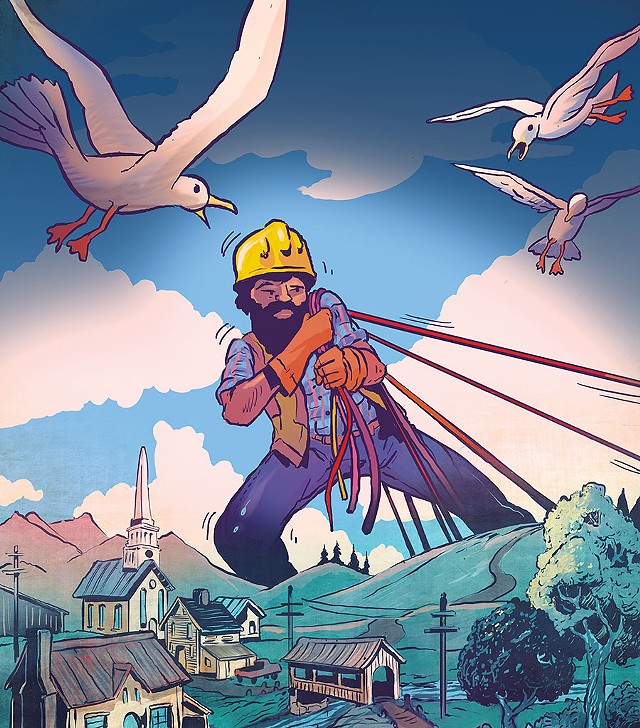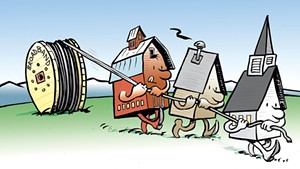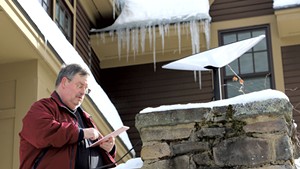
- Michael Tonn
When lawmakers learned that Vermont was receiving $1.25 billion through the federal Coronavirus Relief Fund, many hoped they could steer a hefty chunk toward finally expanding broadband internet access to people who need it more than ever.
After all, advocates argue, if the government is going to require people to work and learn from home, it has an obligation to provide the tools to make that achievable — not only in cities but in rural places such as the Northeast Kingdom.
Legislative committees began to discuss spending as much as $100 million to eliminate the state's digital divide once and for all. A major problem quickly emerged: The federal Coronavirus Relief Fund came with restrictions, including the proviso that the money be spent by the end of this year.
Since broadband networks generally take years to design, finance, permit and build, simply throwing money at the problem wasn't going to improve connectivity.
"You have to engineer these networks," said Rep. Laura Sibilia (I-Dover). "You don't just, like, snap your fingers and it's built."
Lawmakers have had to acknowledge that the state's complex connectivity challenges defy short-term fixes.
Sibilia is vice chair of the House Energy and Technology Committee, which dramatically scaled back its nearly $100 million preliminary recommendation after learning the limits on how federal Coronavirus Aid, Relief and Economic Security Act money can be spent.
The committee initially discussed allocating $45 million of that $100 million to build fiber-optic internet connections with download speeds of 100 megabits per second. Those lightning-fast speeds are available to fewer than one in five buildings in Vermont, according to the Department of Public Service. The state's goal is to make such speeds available everywhere by 2024.
"I think this is what a lot of Vermonters, and frankly a lot of legislators, would like to see us be able to do," Rep. Tim Briglin (D-Thetford), told House Energy and Technology Committee colleagues last week as they drafted their broadband bill.
But that proved impossible, Briglin said. The latest federal guidance states that the coronavirus funds must be spent on "necessary expenditures incurred due to the public health emergency."
Another $7 million sought by the committee for preconstruction engineering and design work to help providers — established national players such as Comcast, as well as homegrown networks in voter-backed community utility districts — was also deemed out of bounds.
"The Joint Fiscal Office and the consultant they are working with very much gave a thumbs-down to that idea," Briglin told his colleagues.
The consultant, Danna MacKenzie, testified in the Senate Finance Committee on Tuesday that initially "there was a lot of optimism and hope that these funds could be used directly to start working on Vermont's long-term broadband planning."
But recent guidance from the U.S. Department of the Treasury clarified that was "not the intent" of the federal aid. The funds come with a "severe limitation" that they can only be used to connect to broadband people who need it for K-12 education, telehealth and telework, she said.
MacKenzie acknowledged that her firm was taking the "most conservative" view of how the money could be spent because the federal government could demand repayment of funds spent inappropriately.
The broadband bill has been downsized to $43 million, with just a fraction of that funding dedicated to expanding internet access for residents. The House is expected to vote on the bill this week.
The measure includes $20 million to compensate utilities — not just telecoms such as Comcast, but also electric and gas companies — for the cost of continuing to serve people who stopped paying bills due to COVID-19. The bill sets aside $7.3 million for the Agency of Digital Services to make it more secure for state employees to work remotely and to upgrade the obsolete unemployment insurance computer system.
The bill also includes $500,000 for a "telecommunications recovery plan" and $466,500 for local cable access organizations in recognition of the additional coverage they've taken on during the pandemic.
That leaves only about $13 million in proposed spending to connect Vermonters to broadband internet services. The bulk of that, $11 million, would create a program to be managed by the public service department called Get Vermonters Connected Now.
The money would provide subsidies to low-income Vermonters who can't afford to use broadband networks already available in their neighborhoods. Internet providers could also tap the fund to extend lines to addresses they don't reach, a service that can cost homeowners thousands of dollars.
Here, however, lawmakers face a major dilemma: How can they encourage existing telecoms to expand their coverage to underserved areas without undermining the communications districts popping up around the state to solve this very problem?
The legislature sent communities a message last year that "no one is coming to save you" when it comes to building out broadband networks, Sibilia said. Instead, the legislature passed a package of tools to make it easier for communities to band together to seek loans or grants to create telecom systems themselves.
The model has worked well in the Upper Valley, where 24 towns organized the first such district in 2011. The East Central Vermont Telecommunications District's nonprofit service, ECFiber, now provides fiber-optic connections to about 13,000 residential customers.
There are currently six districts in the state, three of which — the NEK, Deerfield Valley and Southern Vermont communication union districts — were formed this year.
Evan Carlson, board chair of the new NEK district, said the connection challenges in the Northeast Kingdom permeate every aspect of life.
He pays $120 a month to a satellite internet provider for "really bad" service at his Sutton home. It took six months, he said, to get a fiber-optic line run to the Do North Coworking space in Lyndonville, where he is entrepreneur-in-residence.
"I feel the pain every day," Carlson said. "For me, it's very real to get this problem solved, not just for me, but for all my neighbors."
Dreams of a sweeping statewide solution went out the window long ago as it became clear that the state lacks the financial capacity to pull it off, he said.
To string fiber throughout all 27 towns in the NEK district would cost an estimated $77 million, Carlson said. A 2019 report pegged the cost of extending broadband to the entire state at nearly $300 million, a figure Carlson said is probably far too low.
"I just don't see the state ever unleashing the true volume of funds that are needed to do this in an efficient and effective way," he said.
Some legislators expressed discomfort with abandoning the search for a statewide solution. Rep. Seth Chase (D-Colchester) told his colleagues he wants to keep that goal, however difficult, alive.
"My hope is we can work toward one cohesive network where every corner of Vermont is connected, and not just little pockets at a time," Chase said.
But the piecemeal approach that local districts take holds great promise, Carlson said. Districts can be more responsive to community needs, he said.
He pointed to a proposed project to provide wireless internet access for Northeast Kingdom families with schoolchildren as a good example of solutions that can be rolled out quickly.
The idea, put forth by Stowe-based Cloud Alliance and other partners, would install next-generation fixed wireless antennas on existing towers at Burke Mountain and in Lyndonville. While not an ideal solution, it's a low-cost option that can help people now, Sibilia said.
"What is the fastest technology that we could get up that could cover the most amount of people? It's fixed wireless," she said.
The key is to figure out how to subsidize expansion without harming the financial viability of local districts that are just getting rolling. They'll need wide support if they are eventually to provide universal broadband.
To this end, the broadband bill includes a provision that would give districts some say in how the line-extension subsidies are doled out. Before the state grants funding for line extensions, districts would have 30 days to object if they're worried the subsidies will allow a provider to cherry-pick customers.
"How do we act in a way that connects Vermonters but does not undercut the very Vermonters who have stepped forward to solve this problem once and for all?" Sibilia said. "It's a really fine balancing act."














Comments
Comments are closed.
From 2014-2020, Seven Days allowed readers to comment on all stories posted on our website. While we've appreciated the suggestions and insights, right now Seven Days is prioritizing our core mission — producing high-quality, responsible local journalism — over moderating online debates between readers.
To criticize, correct or praise our reporting, please send us a letter to the editor or send us a tip. We’ll check it out and report the results.
Online comments may return when we have better tech tools for managing them. Thanks for reading.